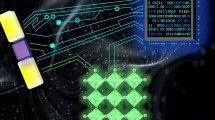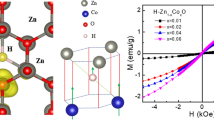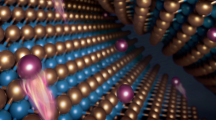Abstract
Effective techniques capable of tuning the properties of van der Waals (vdW) layered materials in a controllable as well as reversible manner are elusive. To demonstrate our proposed technique, an advantageous two-dimensional heterostructure (HS) is modeled using ZrO2 and MoS2 layers. Afterwards, variation of structural, electronic, interfacial and optical properties is performed by sliding one layer of the intercalated ZrO2/MoS2 vdW-HS over another. Electronic band structure calculations show a transition from metallic to semiconducting character upon Li intercalation. As the layer-sliding proceeds, mixing of bands across the Fermi level occurs and is intensified resulting in a metallic character vdW-HS obtained at the completion of the sliding pathway. It is found that Li-intercalation greatly upturns the charge transfer towards 2H–ZrO2 layer as compared to the unintercalated vdW-HS. Dielectric function is profoundly affected by Li-intercalation, and the maximum absorption region and polarization is reduced by 31 and 28%, respectively.
Graphical abstract









Similar content being viewed by others
Data availability
The datasets generated during and/or analyzed during the current study are available from the corresponding author on reasonable request.
References
V. Zatko et al., Band-gap landscape engineering in large-scale 2D semiconductor van der Waals heterostructures. ACS Nano 15(4), 7279–7289 (2021). https://doi.org/10.1021/acsnano.1c00544
G. Swain, S. Sultana, K. Parida, A review on vertical and lateral heterostructures of semiconducting 2D-MoS2 with other 2D materials: a feasible perspective for energy conversion. Nanoscale 13(22), 9908–9944 (2021). https://doi.org/10.1039/D1NR00931A
G. Barik, S. Pal, 2D MoS2–MoSe2 and MoS2–NbS2 lateral heterostructures as anode materials for LIBs/SIBs. Appl. Surf. Sci. 596, 153529 (2022). https://doi.org/10.1016/j.apsusc.2022.153529
C.C. Tho et al., Cataloguing MoSi2N4 and WSi2N4 van der Waals heterostructures: an exceptional material platform for excitonic solar cell applications. Adv. Mater. Interfaces 10(2), 2201856 (2023). https://doi.org/10.1002/admi.202201856
D. Singh, R. Ahuja, Two-dimensional perovskite/HfS2 van der Waals heterostructure as an absorber material for photovoltaic applications. ACS Appl. Energy Mater. 5(2), 2300–2307 (2022). https://doi.org/10.1021/acsaem.1c03796
K. Si et al., A two-dimensional MoS2/WSe2 van der Waals heterostructure for enhanced photoelectric performance. Appl. Surf. Sci. 507, 145082 (2020). https://doi.org/10.1016/j.apsusc.2019.145082
H. Fang et al., Strong interlayer coupling in van der Waals heterostructures built from single-layer chalcogenides. Proc. Natl. Acad. Sci. U.S.A. 111(17), 6198–6202 (2014). https://doi.org/10.1073/pnas.1405435111
Z. Wang et al., Recent progress in 2D van der Waals heterostructures: fabrication, properties, and applications. Sci. China Inform. Sci. 65(11), 1–28 (2022). https://doi.org/10.1007/s11432-021-3432-6
A. Patel et al., Optoelectronic properties of 2D van der Waals heterostructure As/PtS2 by first-principles calculations. Mater. Today: Proc. (2022). https://doi.org/10.1016/j.matpr.2022.07.099
Q.H. Wang et al., Electronics and optoelectronics of two-dimensional transition metal dichalcogenides. Nat. Nanotechnol. 7(11), 699 (2012). https://doi.org/10.1038/nnano.2012.193
A.V. Kolobov, J. Tominaga, Bulk TMDCs: review of structure and properties, in Two-dimensional transition-metal dichalcogenides. (Springer, Cham, 2016), pp.29–77
R. Lv et al., Transition metal dichalcogenides and beyond: synthesis, properties, and applications of single-and few-layer nanosheets. Acc. Chem. Res. 48(1), 56–64 (2015). https://doi.org/10.1021/ar5002846
S. Alkis et al., Thin film MoS2 nanocrystal based ultraviolet photodetector. Opt. Express 20(19), 21815–21820 (2012). https://doi.org/10.1364/OE.20.021815
R. Chen et al., Free-standing hierarchically sandwich-type tungsten disulfide nanotubes/graphene anode for lithium-ion batteries. Nano Lett. 14(10), 5899–5904 (2014). https://doi.org/10.1021/nl502848z
K.F. Mak et al., Atomically thin MoS2: a new direct-gap semiconductor. Phys. Rev. Lett. 105(13), 136805 (2010). https://doi.org/10.1103/PhysRevLett.105.136805
A. Splendiani et al., Emerging photoluminescence in monolayer MoS2. Nano Lett. 10(4), 1271–1275 (2010). https://doi.org/10.1021/nl903868w
J. Weng, S.-P. Gao, A honeycomb-like monolayer of HfO2 and the calculation of static dielectric constant eliminating the effect of vacuum spacing. Phys. Chem. Chem. Phys. 20(41), 26453–26462 (2018). https://doi.org/10.1039/C8CP04743J
J. Weng, S.-P. Gao, Structures and characteristics of atomically thin ZrO2 from monolayer to bilayer and two-dimensional ZrO2–MoS2 heterojunction. RSC Adv. 9(57), 32984–32994 (2019). https://doi.org/10.1039/C9RA06074J
Y. Guo et al., Eighteen functional monolayer metal oxides: wide bandgap semiconductors with superior oxidation resistance and ultrahigh carrier mobility. Nanoscale Horiz. 4(3), 592–600 (2019). https://doi.org/10.1039/C8NH00273H
C. Ataca, H. Sahin, S. Ciraci, Stable, single-layer MX2 transition-metal oxides and dichalcogenides in a honeycomb-like structure. J. Phys. Chem. C 116(16), 8983–8999 (2012). https://doi.org/10.1021/jp212558p
A. Molina-Sanchez, K. Hummer, L. Wirtz, Vibrational and optical properties of MoS2: from monolayer to bulk. Surf. Sci. Rep. 70(4), 554–586 (2015). https://doi.org/10.1016/j.surfrep.2015.10.001
S. Balendhran et al., Two-dimensional molybdenum trioxide and dichalcogenides. Adv. Func. Mater. 23(32), 3952–3970 (2013). https://doi.org/10.1002/adfm.201300125
Y. Zhang et al., A comparison study of the structural and mechanical properties of cubic, tetragonal, monoclinic, and three orthorhombic phases of ZrO2. J. Alloy. Compd. 749, 283–292 (2018). https://doi.org/10.1016/j.jallcom.2018.03.253
W.W. Anku et al., Cobalt doped ZrO2 decorated multiwalled carbon nanotube: a promising nanocatalyst for photodegradation of indigo carmine and eosin Y dyes. Progress Nat. Sci.: Mater. Int. 26(4), 354–361 (2016). https://doi.org/10.1016/j.pnsc.2016.06.007
W.W. Anku et al., Palladium-doped–ZrO2–multiwalled carbon nanotubes nanocomposite: an advanced photocatalyst for water treatment. Appl. Phys. A 122(6), 1–8 (2016). https://doi.org/10.1007/s00339-016-0086-8
Z. Shu, X. Jiao, D. Chen, Hydrothermal synthesis and selective photocatalytic properties of tetragonal star-like ZrO2 nanostructures. CrystEngComm 15(21), 4288–4294 (2013). https://doi.org/10.1039/C3CE40234G
Y. Hao et al., Multilayer and open structure of dendritic crosslinked CeO2–ZrO2 composite: enhanced photocatalytic degradation and water splitting performance. Int. J. Hydrogen Energy 42(9), 5916–5929 (2017). https://doi.org/10.1016/j.ijhydene.2017.01.093
K. Xu et al., The role of Anderson’s rule in determining electronic, optical and transport properties of transition metal dichalcogenide heterostructures. Phys. Chem. Chem. Phys. 20(48), 30351–30364 (2018). https://doi.org/10.1039/C8CP05522J
Y. Kim et al., Synthesis of two-dimensional MoS2/graphene heterostructure by atomic layer deposition using MoF6 precursor. Appl. Surf. Sci. 494, 591–599 (2019). https://doi.org/10.1016/j.apsusc.2019.07.168
Q. Zhang et al., Two-dimensional layered heterostructures synthesized from core–shell nanowires. Angew. Chem. Int. Ed. 54(31), 8957–8960 (2015). https://doi.org/10.1002/anie.201502461
S. Rathi et al., Tunable electrical and optical characteristics in monolayer graphene and few-layer MoS2 heterostructure devices. Nano Lett. 15(8), 5017–5024 (2015). https://doi.org/10.1021/acs.nanolett.5b01030
X. Ji et al., High-performance photodetectors based on MoTe2–MoS2 van der Waals heterostructures. ACS Omega 7(12), 10049–10055 (2022). https://doi.org/10.1021/acsomega.1c06009
P.-Z. Jia et al., Excellent thermoelectric performance induced by interface effect in MoS2/MoSe2 van der Waals heterostructure. J. Phys. Condens. Matter 32(5), 055302 (2019). https://doi.org/10.1088/1361-648X/ab4cab
H. Zhao et al., Type-II van der Waals heterostructures based on AsP and transition metal dichalcogenides: great promise for applications in solar cell. Phys. Status Solidi (RRL)—Rapid Res. Lett. (2022). https://doi.org/10.1002/pssr.202200043
V. Patel et al., Optoelectronic properties of 2D heterojunction ZrO2–MoS2 material using first-principles calculations. Solid State Commun. 334, 114358 (2021). https://doi.org/10.1016/j.ssc.2021.114358
J. Ni et al., Using van der Waals heterostructures based on two-dimensional InSe–XS2 (X = Mo, W) as promising photocatalysts for hydrogen production. J. Mater. Chem. C 8(36), 12509–12515 (2020). https://doi.org/10.1039/D0TC02874F
S. Li et al., Ta3N5/CdS core–shell S-scheme heterojunction nanofibers for efficient photocatalytic removal of antibiotic tetracycline and Cr (VI): performance and mechanism insights. Adv. Fiber Mater. (2023). https://doi.org/10.1007/s42765-022-00253-5
S. Li et al., S-Scheme photocatalyst TaON/Bi2WO6 nanofibers with oxygen vacancies for efficient abatement of antibiotics and Cr (VI): intermediate eco-toxicity analysis and mechanistic insights. Chin. J. Catal. 43(10), 2652–2664 (2022). https://doi.org/10.1016/S1872-2067(22)64106-8
M. Cai et al., Novel Cd0.5Zn0.5S/Bi2MoO6 S-scheme heterojunction for boosting the photodegradation of antibiotic enrofloxacin: degradation pathway, mechanism and toxicity assessment. Sep. Purif. Technol. 304, 122401 (2023). https://doi.org/10.1016/j.seppur.2022.122401
S. Li et al., Enhanced antibiotic degradation performance of Cd0.5Zn0.5S/Bi2MoO6 S-scheme photocatalyst by carbon dot modification. J. Mater. Sci. Technol. (2023). https://doi.org/10.1016/j.jmst.2023.05.009
C. Wang et al., A novel organic/inorganic S-scheme heterostructure of TCPP/Bi12O17Cl2 for boosting photodegradation of tetracycline hydrochloride: kinetic, degradation mechanism, and toxic assessment. Appl. Surf. Sci. 610, 155346 (2023). https://doi.org/10.1016/j.apsusc.2022.155346
S. Li et al., Constructing Cd0.5Zn0.5S/Bi2WO6 S-scheme heterojunction for boosted photocatalytic antibiotic oxidation and Cr (VI) reduction. Adv. Powder Mater. 2(1), 100073 (2023). https://doi.org/10.1016/j.apmate.2022.100073
C.-H. Yang, S.-T. Chang, First-principles study of the optical properties of TMDC/graphene heterostructures. Photonics (2022). https://doi.org/10.3390/photonics9060387
J. Fan, M. Sun, Transition metal dichalcogenides (TMDCs) heterostructures: synthesis, excitons and photoelectric properties. Chem. Record (2022). https://doi.org/10.1002/tcr.202100313
X. Li et al., A two-dimensional MoS2/SnS heterostructure for promising photocatalytic performance: first-principles investigations. Physica E 126, 114453 (2021). https://doi.org/10.1016/j.physe.2020.114453
K. Zhang et al., Construction of S-scheme g-C3N4/ZrO2 heterostructures for enhancing photocatalytic disposals of pollutants and electrocatalytic hydrogen evolution. Dyes Pigm. 180, 108525 (2020). https://doi.org/10.1016/j.dyepig.2020.108525
C. Rakhi, K. Preetha, Synthesis and characterization of ZrO2/Bi2MoO6 heterostructured thin films for optoelectronic and photocatalytic applications. Appl. Phys. A 128(1), 1–12 (2022). https://doi.org/10.1007/s00339-021-05161-w
E. Długoń et al., Anticorrosive ZrO2 and ZrO2–SiO2 layers on titanium substrates for biomedical applications. Surf. Coat. Technol. 331, 221–229 (2017). https://doi.org/10.1016/j.surfcoat.2017.10.011
J. Li et al., Design, preparation, and durability of TiO2/SiO2 and ZrO2/SiO2 double-layer antireflective coatings in crystalline silicon solar modules. Sol. Energy 89, 134–142 (2013). https://doi.org/10.1016/j.solener.2012.12.011
E.D. Sherly et al., A comparative study of the effects of CuO, NiO, ZrO2 and CeO2 coupling on the photocatalytic activity and characteristics of ZnO. Korean J. Chem. Eng. 33(4), 1431–1440 (2016). https://doi.org/10.1007/s11814-015-0285-6
W. Zhou et al., Multi-modal mesoporous TiO2–ZrO2 composites with high photocatalytic activity and hydrophilicity. Nanotechnology 19(3), 035610 (2007). https://doi.org/10.1088/0957-4484/19/03/035610
S.-W. Zheng et al., Observation of robust charge transfer under strain engineering in two-dimensional MoS2–WSe2 heterostructures. Nanoscale 13(33), 14081–14088 (2021). https://doi.org/10.1039/D1NR02014E
X. Zhao et al., Biaxial strain improving the thermoelectric performance of a two-dimensional MoS2/WS2 heterostructure. ACS Appl. Electron. Mater. 3(7), 2995–3004 (2021). https://doi.org/10.1021/acsaelm.1c00187
M. Yousaf et al., Effect of layer sliding on the interfacial electronic properties of intercalated silicene/indium selenide van der Waals heterostructure. Commun. Theor. Phys. 74(3), 035701 (2022). https://doi.org/10.1088/1572-9494/ac450f
R. Gao et al., Two-dimensional MoS2/GaN van der Waals heterostructures: tunable direct band alignments and excitonic optical properties for photovoltaic applications. J. Phys. D Appl. Phys. 53(9), 095107 (2019). https://doi.org/10.1088/1361-6463/ab5ab9
F.A. Rasmussen, K.S. Thygesen, Computational 2D materials database: electronic structure of transition-metal dichalcogenides and oxides. J. Phys. Chem. C 119(23), 13169–13183 (2015). https://doi.org/10.1021/acs.jpcc.5b02950
B. Qiu et al., Optical properties of graphene/MoS2 heterostructure: first principles calculations. Nanomaterials 8(11), 962 (2018). https://doi.org/10.3390/nano8110962
M. Mubashir et al., Efficient hydrogen storage in LiMgF3: a first principle study. Int. J. Hydrogen Energy (2023). https://doi.org/10.1016/j.ijhydene.2023.08.131
S. Li et al., Facile fabrication of TaON/Bi2MoO6 core–shell S-scheme heterojunction nanofibers for boosting visible-light catalytic levofloxacin degradation and Cr (VI) reduction. Chem. Eng. J. 428, 131158 (2022). https://doi.org/10.1016/j.cej.2021.131158
S. Li et al., Rationally designed Ta3N5/BiOCl S-scheme heterojunction with oxygen vacancies for elimination of tetracycline antibiotic and Cr (VI): performance, toxicity evaluation and mechanism insight. J. Mater. Sci. Technol. 123, 177–190 (2022). https://doi.org/10.1016/j.jmst.2022.02.012
S. Li et al., S-scheme MIL-101 (Fe) octahedrons modified Bi2WO6 microspheres for photocatalytic decontamination of Cr (VI) and tetracycline hydrochloride: synergistic insights, reaction pathways, and toxicity analysis. Chem. Eng. J. 455, 140943 (2023). https://doi.org/10.1016/j.cej.2022.140943
S. Li et al., Facile construction of novel Bi2WO6/Ta3N5 Z-scheme heterojunction nanofibers for efficient degradation of harmful pharmaceutical pollutants. Chem. Eng. J. 402, 126165 (2020). https://doi.org/10.1016/j.cej.2020.126165
P. Giannozzi et al., QUANTUM ESPRESSO: a modular and open-source software project for quantum simulations of materials. J. Phys. Condens. Matter 21(39), 395502 (2009). https://doi.org/10.1088/0953-8984/21/39/395502
J.P. Perdew, Y. Wang, Accurate and simple analytic representation of the electron-gas correlation energy. Phys. Rev. B 45(23), 13244 (1992). https://doi.org/10.1103/PhysRevB.45.13244
M. Schlüter, D. Hamann, C. Chiang, Norm-conserving pseudopotentials. Phys. Rev. Lett. 43, 1494–1497 (1979). https://doi.org/10.1103/PhysRevLett.43.1494
N. Trouiller, J.L. Martins, Efficient pseudopotentials for plane-wave calculations Phys. Rev. B: Condens. (1991). https://doi.org/10.1103/PhysRevB.43.1993
Funding
This research received no specific grant from any funding agency.
Author information
Authors and Affiliations
Corresponding author
Ethics declarations
Conflict of interest
The authors declare that there are no conflict of interest in the manuscript.
Additional information
Publisher's Note
Springer Nature remains neutral with regard to jurisdictional claims in published maps and institutional affiliations.
Rights and permissions
Springer Nature or its licensor (e.g. a society or other partner) holds exclusive rights to this article under a publishing agreement with the author(s) or other rightsholder(s); author self-archiving of the accepted manuscript version of this article is solely governed by the terms of such publishing agreement and applicable law.
About this article
Cite this article
Younis, M.W., Akhter, T., Yousaf, M. et al. Layer-sliding-mediated reversible tuning of interfacial electronic and optical properties of intercalated ZrO2/MoS2 van der Waals heterostructure. Journal of Materials Research 38, 4995–5007 (2023). https://doi.org/10.1557/s43578-023-01209-0
Received:
Accepted:
Published:
Issue Date:
DOI: https://doi.org/10.1557/s43578-023-01209-0




